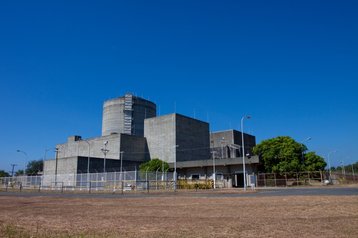The Philippines’ Department of Energy has proposed turning the disused Bataan Nuclear Power Plant (BNPP) into a data center, as the country continues to struggle with the legacy of the failed infrastructure project.
The agency insisted that its main goal is to make the site operational, despite the extensive modernization efforts required - and concerns over the fact that it is located near a major geological fault line and the Mount Pinatubo volcano.
Atomic dreams
The Duterte administration has secured 50 million Philippine pesos (US$964,543) for a feasibility study to ascertain whether the power plant could be brought to life. Should that fail, the DOE will look into other options, foremost amongst them a data center conversion.
“Don’t forget the word ‘data center,’” Energy Secretary Alfonso G. Cusi told reporters at a talk on the future of BNPP, Manila Bulletin reports.
Cusi joked that if the site was turned into a data center, some of the facility’s storage could be used to archive all the issues and complaints the project has caused over the decades, adding: “We also need to bury all of those allegations and issues against the BNPP in that site.”
Such issues are myriad.
In 1973, members of the Organization of Arab Petroleum Exporting Countries proclaimed an oil embargo to target nations OPEC believed were supporting Israel during the Yom Kippur War. This caused shockwaves through the global economy as oil prices quadrupled - with the Philippines among those affected.
To deal with the crisis and insulate the nation from potential global energy market swings, then-Philippine President Ferdinand Marcos announced plans for a nuclear power plant.
Two major proposals were put forward by international businesses hoping to score a contract with the brutal Marcos dictatorship - at the time operating under martial law - General Electric and Westinghouse.
In Vol. 9 of the Reader’s Digest Association’s Kasaysayan: The Story of the Filipino People, it is claimed that General Electric submitted a detailed proposal that estimated the project cost at $700m, while Westinghouse submitted a $500m proposal lacking in specifics.
The presidential committee tasked with overseeing the project preferred GE’s proposal, but in June 1974 Marcos awarded the project to Westinghouse in a letter of intent.
Costs soon increased, with a target of $1.2 billion quoted in 1975, before construction began a year later.
With the 1979 Three Mile Island accident in the United States, fears were raised about BNPP’s safety, leading to an inquiry that uncovered more than 4,000 defects. Speaking about it in 1983, Senator Lorenzo Tanada, a critic of the plant, said: “Mr. Marcos and his nuclear advisers may well be long remembered for having put up the most expensive and dangerous nuclear power plant in the world, thereby saddling present and future generations of Filipinos with enormous foreign loans.”
By 1984 the facility was nearly complete, with costs having reached $2.3bn, offering acess to a technically operational light water reactor capable of 621MW that was never fueled.
Things took a turn in 1986 as it readied for launch, with People Power Revolution of February 22-25 leading to Marcos being overthrown and the nation returning to democracy. With the Chernobyl disaster occuring just two months later, new President Corazon Aquino decided to shelve the project.
Then in 1991, the previously-dormant Mount Pinatubo erupted, ejecting 10 billion metric tons of magma and 20 million tons of sulfur dioxide, suppressing global temperatures by 0.5 °C (0.9 °F) for over two years and renewing concerns about the plant’s location.
It took until April 2007 for the government to fully pay off its obligations on the plant (although it still spends millions on maintenance), after a US court rejected the Philippines’ case against Westinghouse alleging overpricing and bribery.
Plan B
Successive administrations have attempted to revive or kill the site, but little headway has been made. In 2008, the Philippine government-owned and controlled National Power Corporation asked the Korea Electric Power Corp to evaluate the cost of rehabilitating BNPP - the estimate they gave was $1 billion.
The current administration is considering a different approach. With a breakdown in Philippines–US relations during the later years of President Obama’s tenure, Duterte has spoken frequently about increasing trade and forging alliances with China and Russia.
In a visit to Russia this May, Philippine Foreign Affairs Secretary Alan Peter Cayetano signed a memorandum of cooperation between the two nations to pursue the “development of the nuclear infrastructure” in the Philippines. Even if the agreement leads to nuclear progress, it may not happen at the slowly-degrading Bataan, with Russia floating the idea of nuclear power stations on barges.
“[Russia] do have quite a bit of products that they want to sell to the region, particularly energy products and industrial products,” Philippine Ambassador to Russia Carlos Sorreta told Filipino reporters.
“Essentially, we will just buy power from it, put it on a barge offshore and then run cables. Because I know, there is safety issues, nobody wants to build a nuclear reactor on their land.
“It’s actually quite safe, if you’re still afraid of it, you can have the barge parked far away.”
For more on current state of the BNPP, including some beautiful photographs, DCD recommends this feature by Filipino publication Rogue.

